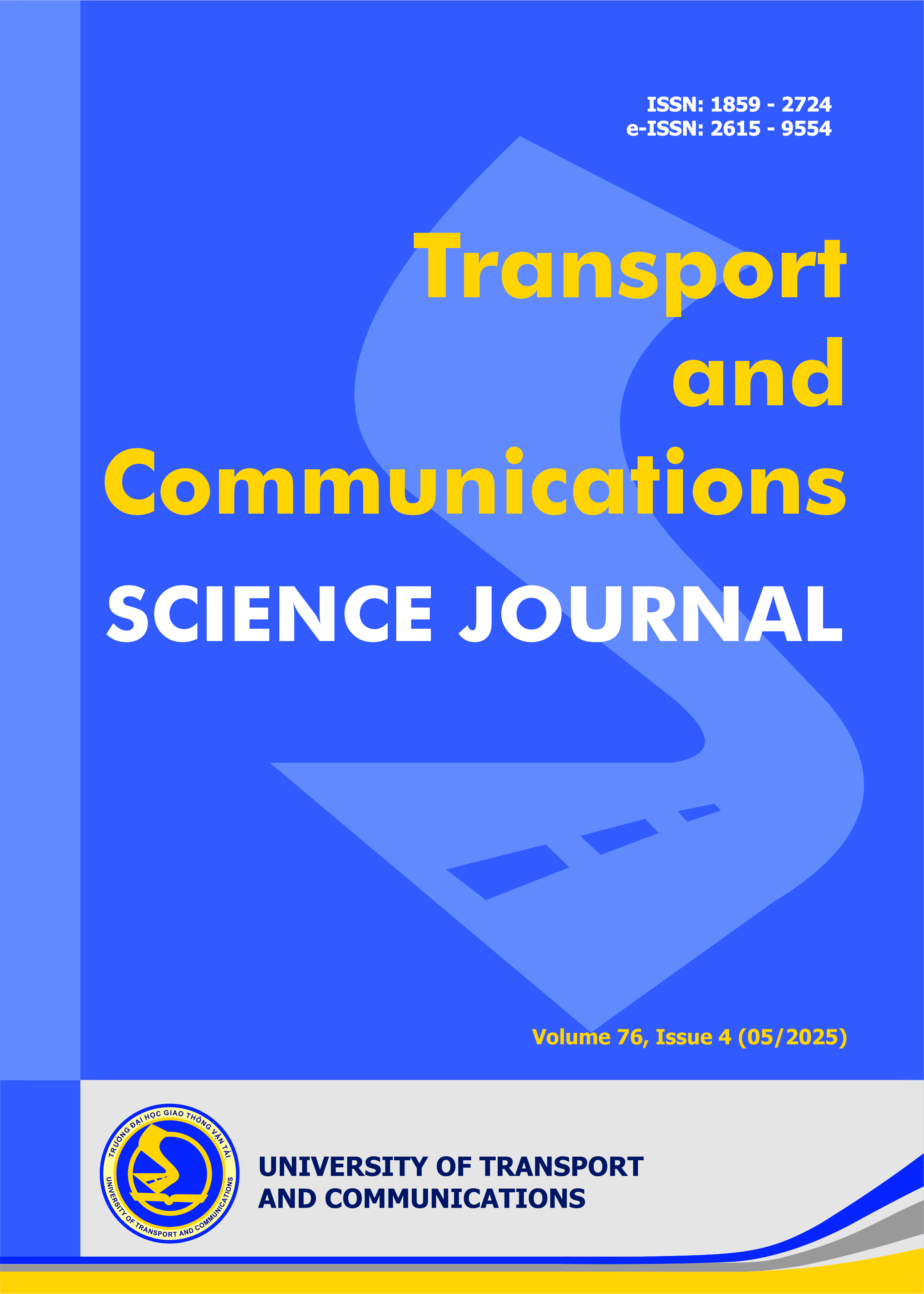Electrical resistance response of a pair of self-sensing concrete blocks under non-destructive compression
Email:
pvngoc@dut.udn.vn
Tóm tắt
Self-sensing concrete is an advanced material capable of monitoring its stress or strain through changes in its electrical resistance. A novelty of this study lies in its focus on the electrical resistance response, not of an individual concrete specimen as in most previous studies, but rather on a pair of self-sensing concrete blocks under non-destructive compression, targeting future applications in large-scale load-weighing systems. The self-sensing concrete samples in the study were fabricated by incorporating carbon fibers into the concrete mixture, creating a conductive network within the material. The experimental setup involved subjecting a robust steel plate to incremental compressive loads, supported by a pair of self-sensing concrete blocks. The corresponding changes in electrical resistance were measured throughout the loading process. Results indicated that each concrete block might exhibit different responses, but their summed response is nearly linear with a high R-squared value above 0.9 and relatively consistent between experimental cases. Additionally, the study highlighted that variations in the current intensity do not significantly affect the resistance response. On the other hand, the locations of concrete blocks relative to the load were identified as a crucial factor affecting the resistance response. Within the scope of this study, the error in the predicted load value corresponding to the resistance variation when experimental parameters are changed is below 10.7%.The findings of this study demonstrate the significant potential of using self-sensing concrete for large-scale load-weighing systems in future smart traffic and logistics management systemsTài liệu tham khảo
[1]. M. Adresi, M. Abedi, W. Dong, M. Yekrangnia, A review of different types of weigh-in-motion sensors: State-of-the-art, Measurement, 225 (2023) 114042. https://doi.org/10.1016/j.measurement.2023.114042
[2]. S. Taheri, A review on five key sensors for monitoring of concrete structures, Construction and Building Materials, 204 (2019) 492-509. https://doi.org/10.1016/j.conbuildmat.2019.01.172
[3]. P.-W. Chen, D.D. Chung, Carbon fiber reinforced concrete for smart structures capable of non-destructive flaw detection, Smart Materials and Structures, 2 (1993) 22-30. https://doi 10.1088/0964-1726/2/1/004
[4]. Z. Tian, Y. Li, J. Zheng, S. Wang, A state-of-the-art on self-sensing concrete: Materials, fabrication and properties, Composites Part B: Engineering, 177 (2019) 107437.
[5]. M.C. Vo, M.H. Nguyen, L. Nguyen, V.H. Nguyen, Stress Self-sensitivity of Carbon Black-filled Mortar under Nondestructive Compression and the Effects of Electric Circuit and Specimen Dimensions, Journal of Advanced Concrete Technology, 21 (2023) 762-776.
[6]. H.V. Le, M. K. Kim, S.U. Kim, S.-Y. Chung, D.J. Kim, Enhancing self-stress sensing ability of smart ultra-high performance concretes under compression by using nano functional fillers, Journal of Building Engineering, 44 (2021) 102717. https://doi.org/10.1016/j.jobe.2021.102717
[7]. D.L. Nguyen, J. Song, C. Manathamsombat, D.J. Kim, Comparative electromechanical damage-sensing behaviors of six strain-hardening steel fiber-reinforced cementitious composites under direct tension, Composites Part B: Engineering, 69 (2015) 159-168. https://doi.org/10.1016/j.compositesb.2014.09.037
[8]. Y. Ding, G. Liu, A. Hussain, F. Pacheco-Torgal, Y. Zhang, Effect of steel fiber and carbon black on the self-sensing ability of concrete cracks under bending, Construction and Building Materials, 207 (2019) 630-639. https://doi.org/10.1016/j.conbuildmat.2019.02.160
[9]. F. Azhari, N. Banthia, Cement-based sensors with carbon fibers and carbon nanotubes for piezoresistive sensing, Cement and Concrete Composites, 34 (2012) 866-873. https://doi.org/10.1016/j.cemconcomp.2012.04.007
[10]. S. Wang, A. Singh, Q. Liu, Experimental study on the piezoresistivity of concrete containing steel fibers, carbon black, and graphene, Frontiers in Materials, 8 (2021) 652614.
[11]. B. Han, K. Zhang, X. Yu, E. Kwon, J. Ou, Nickel particle-based self-sensing pavement for vehicle detection, Measurement, 44 (2011) 1645-1650.
[12]. H. Li, H.-g. Xiao, J.-p. Ou, Effect of compressive strain on electrical resistivity of carbon black-filled cement-based composites, Cement and Concrete Composites, 28 (2006) 824-828.
[13]. H. Wang, X. Gao, R. Wang, The influence of rheological parameters of cement paste on the dispersion of carbon nanofibers and self-sensing performance, Construction and Building Materials, 134 (2017) 673-683. https://doi.org/10.1016/j.conbuildmat.2016.12.176
[14]. L. Vaisman, H.D. Wagner, G. Marom, The role of surfactants in dispersion of carbon nanotubes, Advances in colloid and interface science, 128 (2006) 37-46. https://doi.org/10.1016/j.cis.2006.11.007
[15]. S. Taheri, J. Georgaklis, M. Ams, S. Patabendigedara, A. Belford, S. Wu, Smart self-sensing concrete: the use of multiscale carbon fillers, Journal of Materials Science, 57 (2022) 2667–2682.
[16]. T. Shi, Z. Li, J. Guo, H. Gong, C. Gu, Research progress on CNTs/CNFs-modified cement-based composites–a review, Construction and Building Materials, 202 (2019) 290-307.
[17]. A. D’Alessandro, F. Ubertini, A.L. Materazzi, S. Laflamme, M. Porfiri, Electromechanical modelling of a new class of nanocomposite cement-based sensors for structural health monitoring, Structural Health Monitoring, 14 (2015) 137-147. https://doi.org/10.1177/1475921714560071
[18]. B. Han, K. Zhang, X. Yu, E. Kwon, J. Ou, Fabrication of piezoresistive CNT/CNF cementitious composites with superplasticizer as dispersant, Journal of Materials in Civil Engineering, 24 (2012) 658-665. https://doi.org/10.1061/(ASCE)MT.1943-5533.0000435
[19]. R.M. Chacko, N. Banthia, A.A. Mufti, Carbon-fiber-reinforced cement-based sensors, Canadian Journal of Civil Engineering, 34 (2007) 284-290. https://doi.org/10.1139/l06-092
[20]. F.J. Baeza, O. Galao, E. Zornoza, P. Garcés, Multifunctional cement composites strain and damage sensors applied on reinforced concrete (RC) structural elements, Materials, 6 (2013) 841-855.
[21]. E. García‐Macías, F. Ubertini, Earthquake‐induced damage detection and localization in masonry structures using smart bricks and Kriging strain reconstruction: A numerical study, Earthquake Engineering & Structural Dynamics, 48 (2019) 548-569. https://doi.org/10.1002/eqe.3148
[22]. A. D’Alessandro, H.B. Birgin, G. Cerni, F. Ubertini, Smart infrastructure monitoring through self-sensing composite sensors and systems: A study on smart concrete sensors with varying carbon-based filler, Infrastructures, 7 (2022) 48. https://doi.org/10.3390/infrastructures7040048
[23]. K. Gawel, D. Szewczyk, P.R. Cerasi, Self-sensing well cement, Materials, 14 (2021) 2021. https://doi.org/10.3390/ma14051235
[24]. B. Han, X. Yu, E. Kwon, A self-sensing carbon nanotube/cement composite for traffic monitoring, Nanotechnology, 20 (2009) 445501. doi 10.1088/0957-4484/20/44/445501
[25]. Z.-Q. Shi, D.D Chung, Carbon fiber-reinforced concrete for traffic monitoring and weighing in motion, Cement and Concrete Research, 29 (1999) 435-439. https://doi.org/10.1016/S0008-8846(98)00204-X
[26]. M.C. Vo, M.H. Nguyen, L. Nguyen, V.H. Nguyen, An empirical model for electrical resistivity of mortar considering the synergistic effects of carbon fillers, current intensity, and environmental factors, Case Studies in Construction Materials, 19 (2023) e02685. https://doi.org/10.1016/j.cscm.2023.e02685
[27]. J. Han, J. Pan, J. Cai, X. Li, A review on carbon-based self-sensing cementitious composites, Construction and Building Materials, 265 (2020) 120764.
[28]. M. G. Falara, A.K. Thomoglou, F.I. Gkountakou, A. Elenas, C.E. Chalioris, Hybrid smart cementitious materials incorporating ladder scale carbon fiber reinforcement: An experimental investigation, Case Studies in Construction Materials, 18 (2023), e02035.
[29]. H. Feng, S. Nie, A. Guo, L. Lv, L. Chu, J. Yu, Fresh properties and compressive strength of MPC-based materials with blended mineral admixtures, Case Studies in Construction Materials, 17, e01201, 2022. https://doi.org/10.1016/j.cscm.2022.e01201
[30]. A. ASTM, Standard specification for flow table for use in tests of hydraulic cement, ASTM West Conshohocken, 1 (2014).
[31]. B. Standard, Testing hardened concrete, Compressive strength of test specimens, BS EN 12390-3:2009.
[2]. S. Taheri, A review on five key sensors for monitoring of concrete structures, Construction and Building Materials, 204 (2019) 492-509. https://doi.org/10.1016/j.conbuildmat.2019.01.172
[3]. P.-W. Chen, D.D. Chung, Carbon fiber reinforced concrete for smart structures capable of non-destructive flaw detection, Smart Materials and Structures, 2 (1993) 22-30. https://doi 10.1088/0964-1726/2/1/004
[4]. Z. Tian, Y. Li, J. Zheng, S. Wang, A state-of-the-art on self-sensing concrete: Materials, fabrication and properties, Composites Part B: Engineering, 177 (2019) 107437.
[5]. M.C. Vo, M.H. Nguyen, L. Nguyen, V.H. Nguyen, Stress Self-sensitivity of Carbon Black-filled Mortar under Nondestructive Compression and the Effects of Electric Circuit and Specimen Dimensions, Journal of Advanced Concrete Technology, 21 (2023) 762-776.
[6]. H.V. Le, M. K. Kim, S.U. Kim, S.-Y. Chung, D.J. Kim, Enhancing self-stress sensing ability of smart ultra-high performance concretes under compression by using nano functional fillers, Journal of Building Engineering, 44 (2021) 102717. https://doi.org/10.1016/j.jobe.2021.102717
[7]. D.L. Nguyen, J. Song, C. Manathamsombat, D.J. Kim, Comparative electromechanical damage-sensing behaviors of six strain-hardening steel fiber-reinforced cementitious composites under direct tension, Composites Part B: Engineering, 69 (2015) 159-168. https://doi.org/10.1016/j.compositesb.2014.09.037
[8]. Y. Ding, G. Liu, A. Hussain, F. Pacheco-Torgal, Y. Zhang, Effect of steel fiber and carbon black on the self-sensing ability of concrete cracks under bending, Construction and Building Materials, 207 (2019) 630-639. https://doi.org/10.1016/j.conbuildmat.2019.02.160
[9]. F. Azhari, N. Banthia, Cement-based sensors with carbon fibers and carbon nanotubes for piezoresistive sensing, Cement and Concrete Composites, 34 (2012) 866-873. https://doi.org/10.1016/j.cemconcomp.2012.04.007
[10]. S. Wang, A. Singh, Q. Liu, Experimental study on the piezoresistivity of concrete containing steel fibers, carbon black, and graphene, Frontiers in Materials, 8 (2021) 652614.
[11]. B. Han, K. Zhang, X. Yu, E. Kwon, J. Ou, Nickel particle-based self-sensing pavement for vehicle detection, Measurement, 44 (2011) 1645-1650.
[12]. H. Li, H.-g. Xiao, J.-p. Ou, Effect of compressive strain on electrical resistivity of carbon black-filled cement-based composites, Cement and Concrete Composites, 28 (2006) 824-828.
[13]. H. Wang, X. Gao, R. Wang, The influence of rheological parameters of cement paste on the dispersion of carbon nanofibers and self-sensing performance, Construction and Building Materials, 134 (2017) 673-683. https://doi.org/10.1016/j.conbuildmat.2016.12.176
[14]. L. Vaisman, H.D. Wagner, G. Marom, The role of surfactants in dispersion of carbon nanotubes, Advances in colloid and interface science, 128 (2006) 37-46. https://doi.org/10.1016/j.cis.2006.11.007
[15]. S. Taheri, J. Georgaklis, M. Ams, S. Patabendigedara, A. Belford, S. Wu, Smart self-sensing concrete: the use of multiscale carbon fillers, Journal of Materials Science, 57 (2022) 2667–2682.
[16]. T. Shi, Z. Li, J. Guo, H. Gong, C. Gu, Research progress on CNTs/CNFs-modified cement-based composites–a review, Construction and Building Materials, 202 (2019) 290-307.
[17]. A. D’Alessandro, F. Ubertini, A.L. Materazzi, S. Laflamme, M. Porfiri, Electromechanical modelling of a new class of nanocomposite cement-based sensors for structural health monitoring, Structural Health Monitoring, 14 (2015) 137-147. https://doi.org/10.1177/1475921714560071
[18]. B. Han, K. Zhang, X. Yu, E. Kwon, J. Ou, Fabrication of piezoresistive CNT/CNF cementitious composites with superplasticizer as dispersant, Journal of Materials in Civil Engineering, 24 (2012) 658-665. https://doi.org/10.1061/(ASCE)MT.1943-5533.0000435
[19]. R.M. Chacko, N. Banthia, A.A. Mufti, Carbon-fiber-reinforced cement-based sensors, Canadian Journal of Civil Engineering, 34 (2007) 284-290. https://doi.org/10.1139/l06-092
[20]. F.J. Baeza, O. Galao, E. Zornoza, P. Garcés, Multifunctional cement composites strain and damage sensors applied on reinforced concrete (RC) structural elements, Materials, 6 (2013) 841-855.
[21]. E. García‐Macías, F. Ubertini, Earthquake‐induced damage detection and localization in masonry structures using smart bricks and Kriging strain reconstruction: A numerical study, Earthquake Engineering & Structural Dynamics, 48 (2019) 548-569. https://doi.org/10.1002/eqe.3148
[22]. A. D’Alessandro, H.B. Birgin, G. Cerni, F. Ubertini, Smart infrastructure monitoring through self-sensing composite sensors and systems: A study on smart concrete sensors with varying carbon-based filler, Infrastructures, 7 (2022) 48. https://doi.org/10.3390/infrastructures7040048
[23]. K. Gawel, D. Szewczyk, P.R. Cerasi, Self-sensing well cement, Materials, 14 (2021) 2021. https://doi.org/10.3390/ma14051235
[24]. B. Han, X. Yu, E. Kwon, A self-sensing carbon nanotube/cement composite for traffic monitoring, Nanotechnology, 20 (2009) 445501. doi 10.1088/0957-4484/20/44/445501
[25]. Z.-Q. Shi, D.D Chung, Carbon fiber-reinforced concrete for traffic monitoring and weighing in motion, Cement and Concrete Research, 29 (1999) 435-439. https://doi.org/10.1016/S0008-8846(98)00204-X
[26]. M.C. Vo, M.H. Nguyen, L. Nguyen, V.H. Nguyen, An empirical model for electrical resistivity of mortar considering the synergistic effects of carbon fillers, current intensity, and environmental factors, Case Studies in Construction Materials, 19 (2023) e02685. https://doi.org/10.1016/j.cscm.2023.e02685
[27]. J. Han, J. Pan, J. Cai, X. Li, A review on carbon-based self-sensing cementitious composites, Construction and Building Materials, 265 (2020) 120764.
[28]. M. G. Falara, A.K. Thomoglou, F.I. Gkountakou, A. Elenas, C.E. Chalioris, Hybrid smart cementitious materials incorporating ladder scale carbon fiber reinforcement: An experimental investigation, Case Studies in Construction Materials, 18 (2023), e02035.
[29]. H. Feng, S. Nie, A. Guo, L. Lv, L. Chu, J. Yu, Fresh properties and compressive strength of MPC-based materials with blended mineral admixtures, Case Studies in Construction Materials, 17, e01201, 2022. https://doi.org/10.1016/j.cscm.2022.e01201
[30]. A. ASTM, Standard specification for flow table for use in tests of hydraulic cement, ASTM West Conshohocken, 1 (2014).
[31]. B. Standard, Testing hardened concrete, Compressive strength of test specimens, BS EN 12390-3:2009.
Tải xuống
Chưa có dữ liệu thống kê

Nhận bài
27/11/2024
Nhận bài sửa
15/01/2025
Chấp nhận đăng
09/05/2025
Xuất bản
15/05/2025
Chuyên mục
Công trình khoa học
Kiểu trích dẫn
Vo Minh, C., Nguyen Minh, H., Nguyen, L., Pham Van, N., Nguyen Van, H., & Nguyen Duc, H. (1747242000). Electrical resistance response of a pair of self-sensing concrete blocks under non-destructive compression. Tạp Chí Khoa Học Giao Thông Vận Tải, 76(4), 568-582. https://doi.org/10.47869/tcsj.76.4.10
Số lần xem tóm tắt
86
Số lần xem bài báo
43









